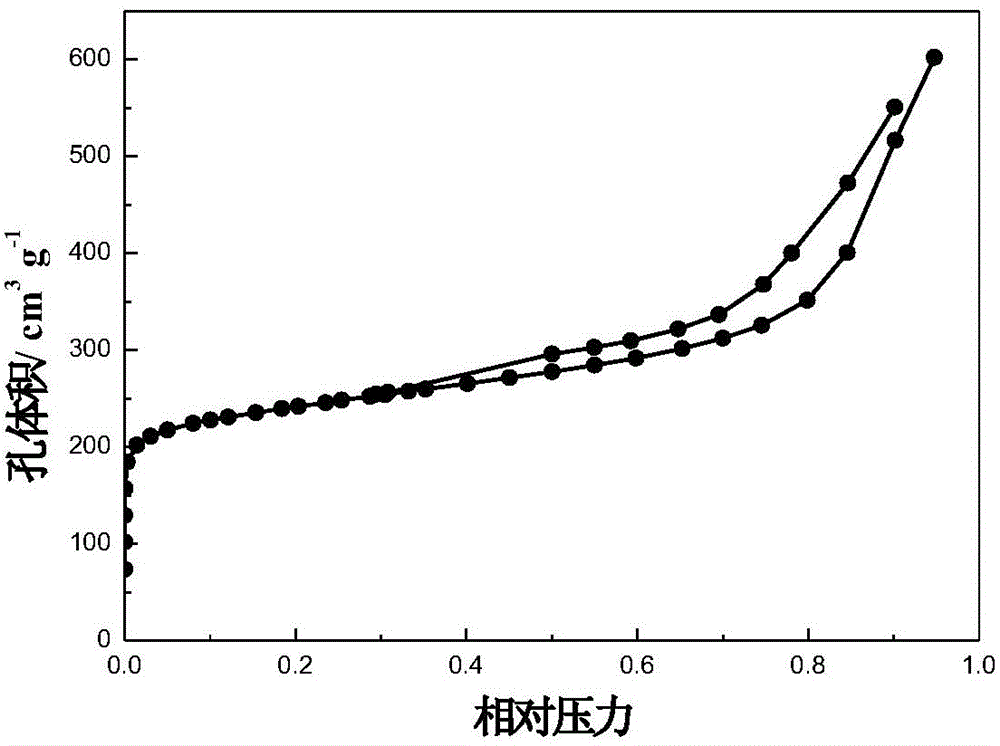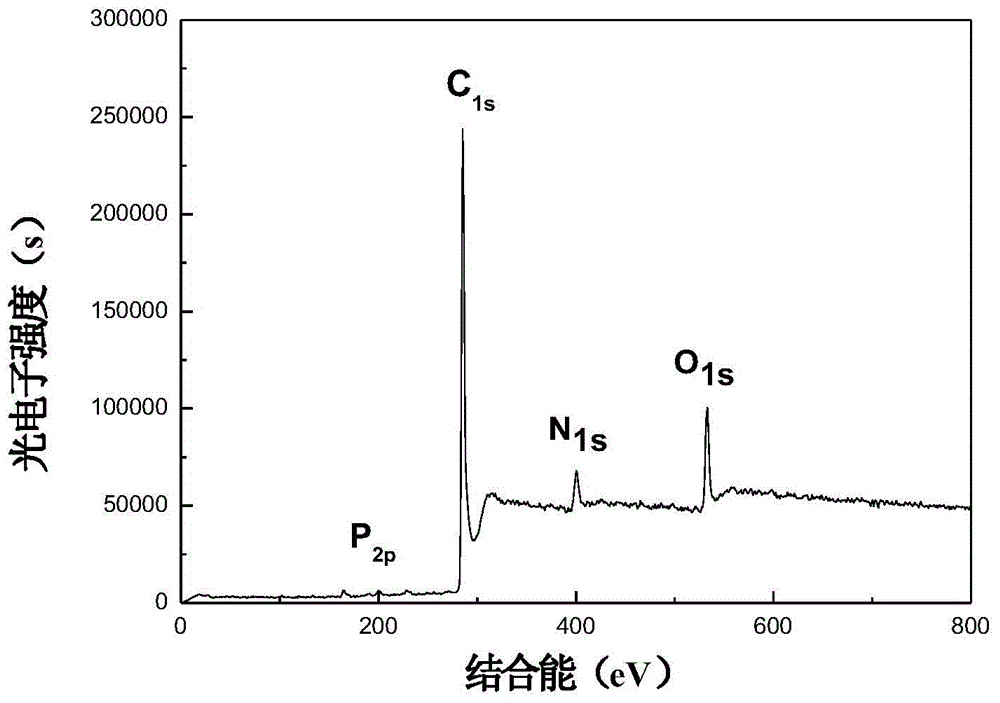Porous phosphor-nitrogen-codoped carbon material and preparation method thereof
A porous carbon material and carbon material technology, applied in the field of carbon materials, can solve problems such as low specific surface area and performance impact
- Summary
- Abstract
- Description
- Claims
- Application Information
AI Technical Summary
Problems solved by technology
Method used
Image
Examples
Embodiment 1
[0036] A. Dissolve 0.20g of triphenylphosphine in 2ml of aniline, stir to dissolve evenly, add to 10mL of 2mol / L hydrochloric acid solvent, stir and mix evenly, then add 5g of silicon dioxide nanosphere silicon-based hard template in turn (Ludox-HS40, purchased by Sigma-Aldrich Company), 0.02g iron nitrate (III) nonahydrate, 0.005g cobalt nitrate (II) hexahydrate, stir well, add 20mL1mol / L ammonium persulfate aqueous solution, at 0 Polymerization was stirred at °C for 24 h to obtain polymer 1.
[0037] B. After polymer 1 is cooled to 25°C, it is transferred to a polytetrafluoroethylene hydrothermal reaction kettle, and reacted at 180°C for 24 hours. After the reaction, it is naturally cooled to 25°C, and the hydrothermal substance is taken out, and dried in a water bath at 80°C. The solid 1 was obtained, and the temperature of the solid 1 was raised to 600° C. at a rate of 10° C. / min under nitrogen protection, and calcined for 1 h. The temperature was lowered to 25°C and take...
Embodiment 2
[0041] A. The quality of triphenylphosphorus is changed to 0.1g, and other processing conditions are the same as in Example 1.
[0042] B. The hydrothermal reaction time is changed to 12h, and other processing conditions are the same as in Example 1.
[0043] C. Same as Example 1 to obtain a porous nitrogen-phosphorus co-doped carbon material.
[0044] The specific surface area of the porous nitrogen-phosphorus co-doped carbon material obtained by nitrogen adsorption and desorption analysis and scanning electron microscopy is 197.7m 2 g -1 , the pore size is mainly 12.7nm pores; the scanning electron microscope energy spectrum shows that the atomic percentages in the porous nitrogen-phosphorus co-doped carbon material are 85.0% carbon, 2.8% oxygen, 4.26% nitrogen, and 0.1% phosphorus.
Embodiment 3
[0046] A. The mass of triphenylphosphine was changed to 0.4g, the silicon-based hard template of silica nanospheres was changed to Ludox-TM40, which was purchased from Sigma-Aldrich, and other processing conditions were the same as in Example 1.
[0047] B. The hydrothermal reaction time was changed to 12 hours, the calcination temperature was changed to 800° C., and only the heating treatment was performed, that is, the holding time was 0 hours, and the other treatment conditions were the same as in Example 1.
[0048] C. Same as Example 1 to obtain a porous nitrogen-phosphorus co-doped carbon material.
[0049] The specific surface area of the porous nitrogen-phosphorus co-doped carbon material obtained by nitrogen adsorption and desorption analysis and scanning electron microscope detection is 142m 2 g -1 , the pore size is mainly 23nm pores; the scanning electron microscope energy spectrum shows that the atomic percentages in the porous nitrogen-phosphorus co-doped carb...
PUM
| Property | Measurement | Unit |
|---|---|---|
| pore size | aaaaa | aaaaa |
Abstract
Description
Claims
Application Information
 Login to View More
Login to View More - R&D
- Intellectual Property
- Life Sciences
- Materials
- Tech Scout
- Unparalleled Data Quality
- Higher Quality Content
- 60% Fewer Hallucinations
Browse by: Latest US Patents, China's latest patents, Technical Efficacy Thesaurus, Application Domain, Technology Topic, Popular Technical Reports.
© 2025 PatSnap. All rights reserved.Legal|Privacy policy|Modern Slavery Act Transparency Statement|Sitemap|About US| Contact US: help@patsnap.com



